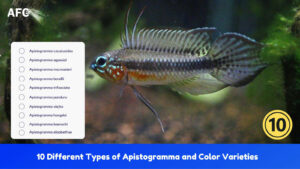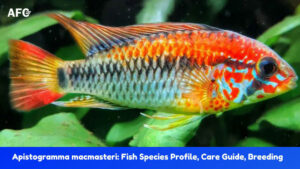Lake Tanganyika is the second deepest lake on Earth and is located in central Africa. Not only is it the backdrop for many stories, but a home to an incredible variety of cichlids that come from a large range of species, sizes, and colors. From the deep green shades to the golden sunset, from the very small (2″) to the very large (15″), there are more than 150 different species of Tanganyika cichlid that have been discovered, and we’re probably still uncovering new ones!
If you’re looking for fascinating, beautiful freshwater African Cichlids and comes in an impressive range of colors, then the Lake Tanganyika cichlids are your best option.
The list below is a great way to see what options are out there for you.
The 10 Most Popular Lake Tanganyika Cichlids
Lemon Cichlid(Neolamprologus leleupi)
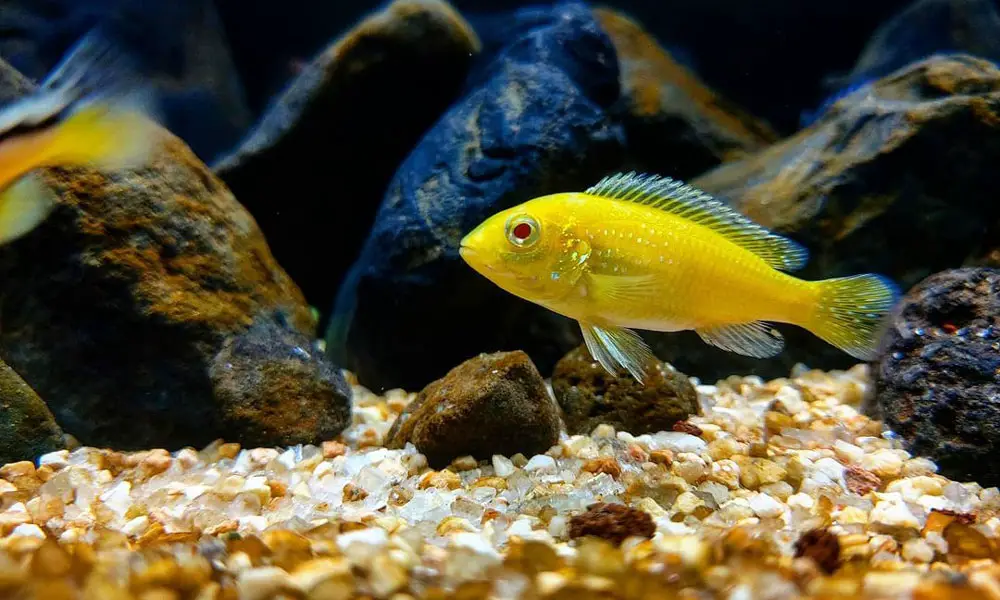
The Lemon Cichlid (Neolamprologus leleupi) is perhaps the best-known cichlid to have ever come from Lake Tanganyika, which owes its popularity because of its most sought-after brilliant yellow/orange coloring. It’s not only a very interesting species due to its peaceful behaviors and characteristics, but it also comes in an impressive range of colors from bright yellow to orange or even dark color variety!
It is a relatively small Tanganyika cichlid in the aquarium trade. Males can grow up to 4 inches (10 cm), while females are slightly smaller at 3 1/2 inches(9 cm) in size! Depending on the location, colorations vary wildly, ranging from bright yellow to deep brown.
This fish is best left in an aquarium with experienced hands. Though it can be cared for by intermediate cichlid lovers, you must provide a properly set up tank and make sure your water parameters stay high quality at all times.
| Common Name: | Lemon Cichlid, Leleupi, Orange Leleupi Cichlid, Gold Leleupi Cichlid |
| Scientific Name: | Neolamprologus leleupi |
| Genus: | Neolamprologus |
| Care Level: | Intermediate |
| Lifespan: | 8 years |
| Size: | 3.9 inches |
| Temperament: | Semi-aggressive |
| Minimum Tank Size: | 20 gal (76 L) |
| Temperature: | 74.0 to 79.0° F |
| PH: | 7.8-9.0 |
| Diet: | Carnivore |
Fairy Cichlid (Neolamprologus brichardi)

The Fairy Cichlid is a fascinating fish that was one of the first African Tanganyika cichlids imported for our aquariums. It was originally known as Princess of Burundi, but today you can find many other common names for this fish: Fairy Cichlid or Brichardi Cichlid.
The Fairy Cichlid has an elongated body and continuous dorsal fin. They also have lyre-shaped tail fins, long flowing filaments on all unpaired fins that can grow up to 6 inches(15 cm) in length.
These fish are known for their elegant appearance and enjoy living in groups. They make an ideal addition to any aquarium, even if you’re just starting out!
| Common Name: | Fairy Cichlid, Brichardi Cichlid, Lyretail Cichlid, Princess of Burundi |
| Scientific Name: | Neolamprologus brichardi |
| Genus: | Neolamprologus |
| Care Level: | Beginner |
| Lifespan: | 8 to 10 years |
| Size: | 5.1 inches |
| Temperament: | Semi-aggressive |
| Minimum Tank Size: | 15 gal (57 L) |
| Temperature: | 72.0 to 77.0° F |
| PH: | 8.0-8.5 |
| Diet: | Omnivore |
Daffodil Cichlid(Neolamprologus pulcher)
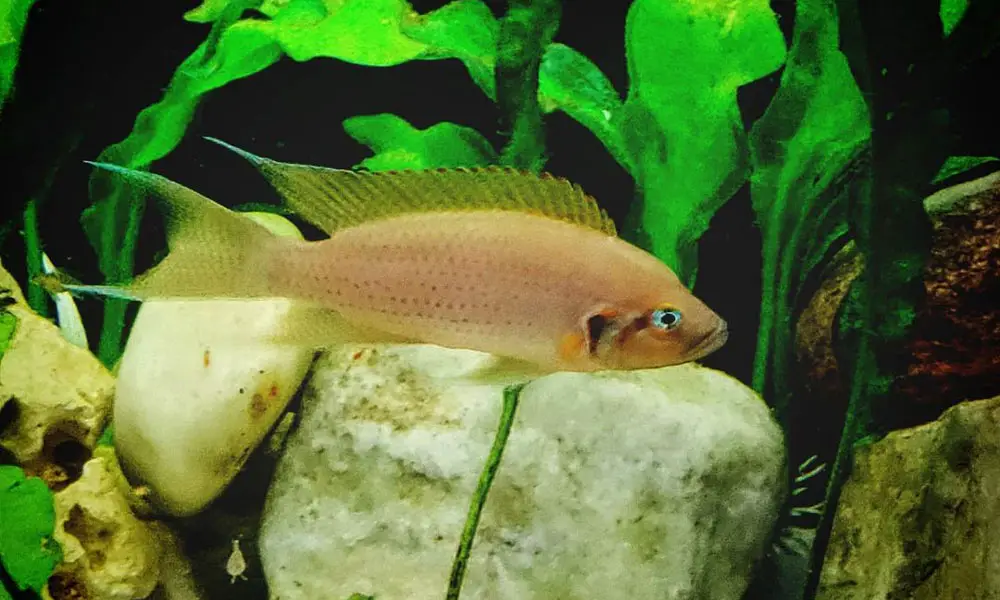
The Daffodil Cichlid is a fun Tanganyika fish species to own. It is one of the most vibrantly colored cichlids in the African rift, has a light-colored tan body coloration with hints of yellow and bluish spots. The bright and icy blue eye is surrounded by a yellowish ring, while its fins are tipped with an icy blue.
Like the Fairy Cichlids, they can grow up to 6 inches (15 cm) in length with proper care. They are schooling fish that pairs off to breed, so they’re best kept in groups. They generally stay peaceful and non-aggressive with their own kind.
In captivity, they prefer similar living conditions. They have a wide range of environmental preferences, can tolerate some fluctuations without any issues. Easy to care for, a good choice for both beginners and advanced fishkeepers.
| Common Name: | Daffodil Cichlid, Daffodil Princess Cichlid, Daffodil II, Princess of Zambia |
| Scientific Name: | Neolamprologus pulcher |
| Genus: | Neolamprologus |
| Care Level: | Beginner |
| Lifespan: | 8 to 10 years |
| Size: | 5.1 inches |
| Temperament: | Semi-aggressive |
| Minimum Tank Size: | 15 gal (57 L) |
| Temperature: | 72.0 to 77.0° F |
| PH: | 8.0-8.5 |
| Diet: | Omnivore |
Calvus Cichlid (Altolamprologus calvus)

As known as White Pearly Calvus, with its pear-shaped body and compressed body coloration, the Calvus Cichlid is a unique cichlid. It belongs to the Altolamprologus genus, which has three identified species and a number of variants. These fish are cave spawners, but sometimes they’ll spawn in shells.
Calvus Cichlids have a steep forehead and high back. They’re able to root out prey from rocks or crevices with their laterally compressed body, making them one of the most efficient fish for hunting food in hard-toed environments.
They are relatively peaceful fish that can be kept with other Tanganyika cichlids of similar size. However, they’re best kept in a species tank if you want to breed them. They can live with peaceful cichlids of a different genus. Be aware that some breeds can’t stand the peace. Do not keep them with Mbuna Cichlids or species from the Tropheus and Petrochromis genera, as these types usually get territorial.
| Common Name: | White Pearly Calvus, Calvus Cichlid, Black Calvus, White Calvus, White Chaitika |
| Scientific Name: | Altolamprologus calvus |
| Genus: | Altolamprologus |
| Care Level: | Intermediate |
| Lifespan: | 8 to 10 years |
| Size: | 5.9 inches |
| Temperament: | Semi-aggressive |
| Minimum Tank Size: | 40 gal (151 L) |
| Temperature: | 73.0 to 77.0° F |
| PH: | 8.0-9.0 |
| Diet: | Carnivore |
Frontosa Cichlid(Cyphotilapia frontosa)

Next up, we have the Frontosa Cichlid. Also known as Humphead cichlid, this fish is a majestic presence in any aquarium. A mature Frontosa Cichlid can reach up to 14 inches (35 cm) or more. With its large size, rich, bold patterns, and compressed body shape, it was immediately considered one of the top picks of Tanganyika cichlids breeders.
Both males and females have the same attractive coloration, but only adults develop a cranial hump on its head. Juveniles do not display this trait because it takes time for them to grow up enough.
Make no mistake, Frontosa Cichlids are stealthy predators that will snatch up any small fish they can find. They are not very aggressive, but the males can be territorial. Gregarious and not keen on being alone, groups of one male with three or more females can live together in a group.
| Common Name: | Frontosa Cichlid, Humphead Cichlid |
| Scientific Name: | Cyphotilapia frontosa |
| Genus: | Cyphotilapia |
| Care Level: | Intermediate |
| Lifespan: | 8 to 10 years |
| Size: | 13.8 inches |
| Temperament: | Semi-aggressive |
| Minimum Tank Size: | 70 gal (265 L) |
| Temperature: | 74.0 to 79.0° F |
| PH: | 8.0-8.5 |
| Diet: | Carnivore |
Duboisi Cichlid (Tropheus duboisi)

The Duboisi Cichlid (Tropheus duboisi) is a fascinating fish to watch grow up because of its amazing color transformation. It starts its life as a drab gray fish but slowly acquires more and more colorful markings as it matures.
The sex of the White Spotted Cichlid is a challenge to determine. Growth rate and body shape can be slightly different between males and females, but they don’t tell the whole story. The most reliable way is by examining its genital papillae. The males have pointy genital, while females are rounded out in shape!
The Tropheus duboisi is one of the most aggressive Tanganyika cichlids. It’s best to keep them in a species-specific in a group of at least 12 or more, with a single male in the group. You need a larger tank if you want to put two males in a group of 15 to 20.
| Common Name: | White Spotted Cichlid, Duboisi Cichlid, Blue-Faced Duboisi Cichlid |
| Scientific Name: | Tropheus duboisi |
| Genus: | Tropheus |
| Care Level: | Advanced |
| Lifespan: | 5 – 8 years |
| Size: | 4.8 inches |
| Temperament: | Aggressive |
| Minimum Tank Size: | 75 gal (284 L) |
| Temperature: | 73.0 to 81.0° F |
| PH: | 8.0-9.5 |
| Diet: | Omnivore |
Sardine Cichlid(Cyprichromis leptosoma)
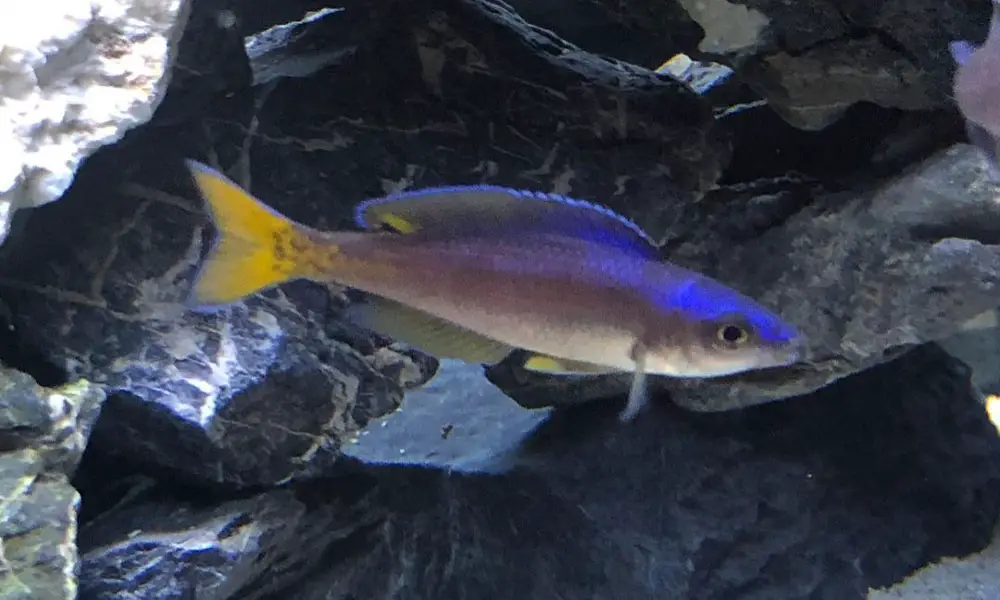
The Sardine Cichlid (Cyprichromis leptosoma) is a great addition to any Lake Tanganyika tank. Unlike most other cichlids that have an appearance of being deep-bodied and robust looking – this fish in the Cyprichromis genus has the opposite; its long slender body makes them look like they’re riding on top water.
The body coloration of a male Sardine Cichlid ranges from lavender to blue; females come with a beige body with some yellow in their fins. The colors of these creatures vary depending on where they are found.
Sardine Cichlid is easy to care for and also fairly peaceful. They can be kept with other Tanganyika cichlids of similar size but should not be housed with aggressive fish. If you’re looking for a relatively undemanding Lake Tanganyika Cichlid that adds a lot of colors, we recommend giving these fish a shot.
| Common Name: | Slender Cichlid, Blue Flash, Slender Cyp, Neonback, Lepto Cichlid |
| Scientific Name: | Cyprichromis leptosoma |
| Genus: | Cyprichromis |
| Care Level: | Beginner |
| Lifespan: | 8 years |
| Size: | 4.3 inches |
| Temperament: | Semi-aggressive |
| Minimum Tank Size: | 55 gal (208 L) |
| Temperature: | 73.0 to 77.0° F |
| PH: | 8.0-9.0 |
| Diet: | Omnivore |
Blue Neon Cichlid (Paracyprichromis nigripinnis)
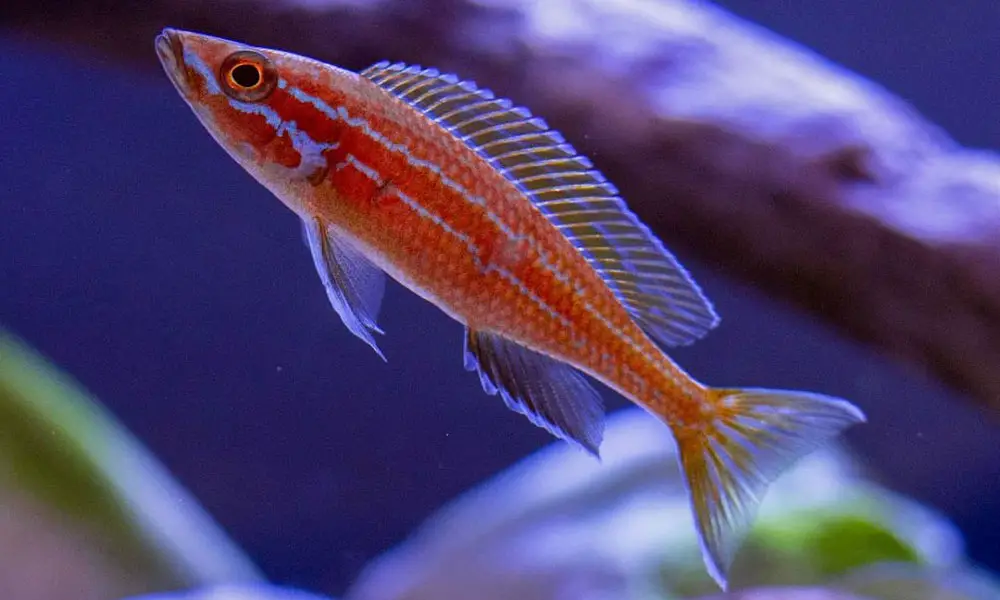
With a gentle nature and vibrant color, the Blue Neon Cichlids are absolute stunners! These eye-catching fish is covered in several bright colors neon striping that look great against on a creamy body.
The Blue Neon Cichlids have a very similar body shape to their close relatives Sardine Cichlid, but they belong to the Paracyprichromis genus, which has a totally different nature, including a milder temperament and smaller body size. The male Blue Neon Cichlids can grow to about 4 inches in length, while females are a bit smaller at just over 3 inches.
Although it is a more peaceful Lake Tanganyika cichlid, this species can be a big challenge to care for by beginners as they tend to be stressed out and fade in color when kept with other boisterous fish.
| Common Name: | Blue Neon Cichlid, Neon Cichlid, Neon Blue, Herring Cichlid |
| Scientific Name: | Paracyprichromis nigripinnis |
| Genus: | Paracyprichromis |
| Care Level: | Intermediate |
| Lifespan: | 5 – 8 years |
| Size: | 4.3 inches |
| Temperament: | Peaceful |
| Minimum Tank Size: | 65 gal (246 L) |
| Temperature: | 77.0 to 81.0° F |
| PH: | 8.0-8.5 |
| Diet: | Omnivore |
Blue Goby Cichlid(Spathodus erythrodon)

The Blue Goby Cichlid is a beautiful species with bright coloration. With brownish gray scales and rows of spots decked out to help it blend in with the surroundings. It’s also known as Blue Lips Goby Cichlid. As its name would imply, the blue lips make quite a splash in your cichlid aquarium.
But that’s not what makes the fish special. They’re colorful with personalities to match! These cichlid’s favorite pastimes is jumping around and playing hide-and-seek game in the aquarium.
When it comes to caring, the Blue Goby Cichlids are easy to moderate to care for because they are sensitive and picky about their environment. This species prefers to stay at the top of the water column, and they can get along with other goby cichlids.
| Common Name: | Blue Goby Cichlid, Blue-Spotted Goby Cichlid, Blue Lips Goby Cichlid |
| Scientific Name: | Spathodus erythrodon |
| Genus: | Spathodus |
| Care Level: | Intermediate |
| Lifespan: | 3 – 5 years |
| Size: | 3.0 inches |
| Temperament: | Semi-aggressive |
| Minimum Tank Size: | 30 gal (114 L) |
| Temperature: | 75.0 to 81.0° F |
| PH: | 8.1-8.6 |
| Diet: | Omnivore |
Blunthead Cichlid (Tropheus moorii)
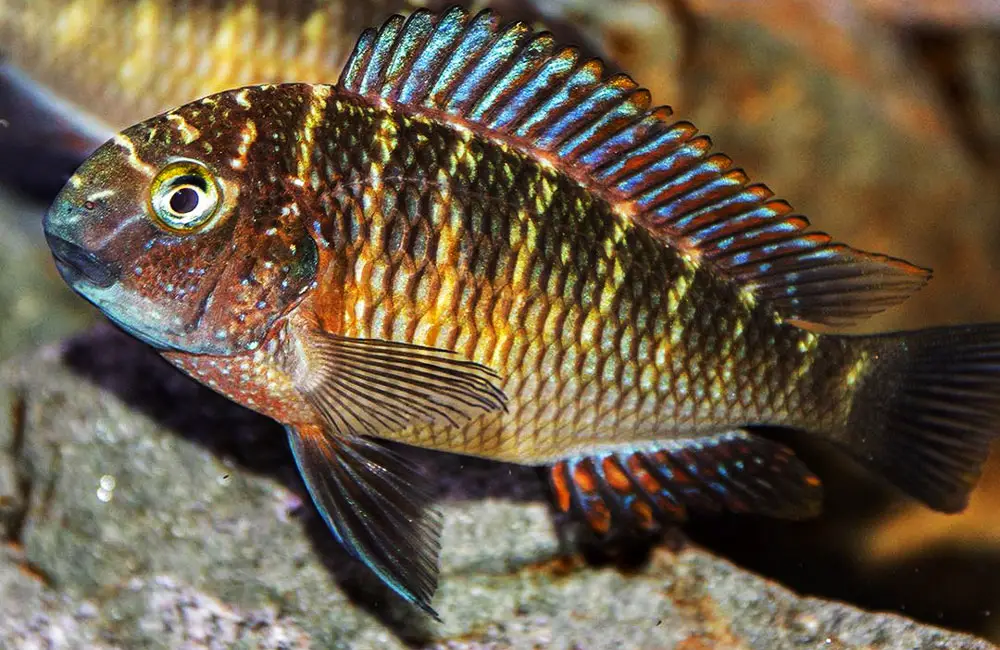
Here’s another unique type of Tanganyika Tropheus Cichlids. It has been reported that the Blunthead Cichlid contains around 50 different color morphs, it is a true champion of variety. Revered for their bright color varieties, the Blunthead Cichlid can’t be missed.
These stocky fish have a larger head, under-slung mouth, fan-shaped caudal fin, and the body narrows towards the caudal peduncle. The back parts of the dorsal, fins and other important places are covered in spiny rays to keep predators at bay.
The Blunthead Cichlids can reach up to 6 inches in length. Like many other Cichlid species, Blunthead Cichlids are quite aggressive fish. They are generally kept in groups, females will help dilute the male’s aggressiveness. Their highly aggressive nature and are susceptibility to “bloat” make them a bit difficult to keep.
| Common Name: | Blunthead Cichlid, Blunt-Headed Cichlid, Moorii, Brabant Cichlid |
| Scientific Name: | Tropheus moorii |
| Genus: | Tropheus |
| Care Level: | Advanced |
| Lifespan: | 5 – 8 years |
| Size: | 5.8 inches |
| Temperament: | Semi-aggressive |
| Minimum Tank Size: | 75 gal (284 L) |
| Temperature: | 76.0 to 82.0° F |
| PH: | 7.0-9.0 |
| Diet: | Omnivore |
Complete List of Lake Tanganyika Cichlid Species
| Genus | Species |
| Altolamprologus | Altolamprologus calvus Altolamprologus compressiceps Altolamprologus sp. “Compressiceps Shell” Altolamprologus fasciatus |
| Aulonocranus | Aulonocranus dewindti |
| Baileychromis | Baileychromis centropomoides |
| Bathybates | Bathybates fasciatus Bathybates ferox Bathybates graueri Bathybates horni Bathybates leo Bathybates minor Bathybates vittatus |
| Benthochromis | Benthochromis melanoides Benthochromis tricoti |
| Boulengerochromis | Boulengerochromis microlepis |
| Callochromis | Callochromis macrops Callochromis melanogostigma Callochromis pleurospilus Callochromis stappersii |
| Cariapharynx | Cariapharynx schoutedeni |
| Chalinochromis | Chalinochromis brichardi Chalinochromis popelini Chalinochromis sp. “Bifrenatus” Chalinochromis sp. “Ndobhoi” |
| Ctenochromis | Ctenochromis benthicola Ctenochromis horii |
| Cunningtonia | Cunningtonia longiventralis |
| Cyathopharynx | Cyathopharynx foai Cyathopharynx furcifer Cyathopharynx cf. furcifer |
| Cyphotilapia | Cyphotilapia frontosa Cyphotilapia gibberosa Cyphotilapia sp. “North” |
| Cyprichromis | Cyprichromis leptosoma Cyprichromis leptosoma sp. “Leptasoma Goldfin” Cyprichromis leptosoma sp. “Leptasoma Jumbo” Cyprichromis leptosoma sp. “Leptasoma Kibige” Cyprichromis microlepidotus Cyprichromis pavo Cyprichromis zonatus |
| Ectodus | Ectodus descampsi Ectodus descampsi sp. “Descampsi North” |
| Enantiopus | Enantiopus melanogenys Enantiopus sp. “Kilesa” |
| Eretmodus | Eretmodus cyanostictus Eretmodus sp. “Cyanostictus North” |
| Gnathochromis | Gnathochromis permaxillaris Gnathochromis pfefferi |
| Grammatotria | Grammatotria lemairii |
| Greenwoodochromis | Greenwoodochromis bellcrossi Greenwoodochromis christyi |
| Haplotaxodon | Haplotaxodon microlepsis Haplotaxodon trifasciatus |
| Hemibates | Hemibates stenosoma |
| Interchromis | Interchromis loocki |
| Julidochromis | Julidochromis dickfeldi Julidochromis marlieri Julidochromis ornatus Julidochromis regani Julidochromis sp. “Chisanza Marmelade” Julidochromis sp. “Congo” Julidochromis sp. “Kissi” Julidochromis sp. aff. “Ornatus Kasenga” Julidochromis transcriptus |
| ‘Lamprologus’ | ‘Lamprologus’ brevis ‘Lamprologus’ callipterus ‘Lamprologus’ calliurus ‘Lamprologus’ caudopuntatus ‘Lamprologus’ sp. “Caudopuntatus Kipili” ‘Lamprologus’ finalimus ‘Lamprologus’ multifasciatus ‘Lamprologus’ ocellatus ‘Lamprologus’ ornatipinnis ‘Lamprologus’ sp. aff. “Ornatipinnis Tembwe II” ‘Lamprologus’ sp. “Ornatipinnis Zambia” ‘Lamprologus’ sp. “Shell Zambia” ‘Lamprologus’ similis ‘Lamprologus’ speciosus ‘Lamprologus’ stappersi ‘Lamprologus’ wauthioni |
| Lepidiolamprologus | Lepidiolamprologus attenuatus Lepidiolamprologus boulengeri Lepidiolamprologus sp. aff. “Boulengeri” Lepidiolamprologus elongatus Lepidiolamprologus hecqui Lepidiolamprologus sp. “Hecqui Boulengeri Complex” Lepidiolamprologus kendalli Lepidiolamprologus lemairii Lepidiolamprologus meeli Lepidiolamprologus sp. “Meeli” Lepidiolamprologus pleuromaculatus Lepidiolamprologus profundicola Lepidiolamprologus sp. “Profundicola” |
| Lestradea | Lestradea perspicax |
| Limnochromis | Limnochromis abeelei Limnochromis auritus Limnochromis staneri |
| Limnotilpia | Limnotilapia dardenni |
| Lobochilotes | Lobochilotes labiatus |
| Microdontochromis | Microdontochromis rotundiventralis Microdontochromis tenuidentatus |
| Neolamprologus | Neolamprologus bifasciatus Neolamprologus brichardi Neolamprologus cf. brichardi Neolamprologus buescheri Neolamprologus christyi Neolamprologus crassus Neolamprologus cunningtonia Neolamprologus cylindricus Neolamprologus sp. “Eseki” Neolamprologus falcicula Neolamprologus furcifer Neolamprologus gracilis Neolamprologus kungweensis Neolamprologus laparogramma Neolamprologus leleupi Neolamprologus cf. leleupi Neolamprologus longicaudatus Neolamprologus marunguensis Neolamprologus modestus Neolamprologus mondabu Neolamprologus mustax Neolamprologus niger Neolamprologus nigriventris Neolamprologus obscurus Neolamprologus pectoralis Neolamprologus petricola Neolamprologus prochilus Neolamprologus pulcher Neolamprologus savoryi Neolamprologus schreyeni Neolamprologus sexfasciatus Neolamprologus signatus Neolamprologus splendens Neolamprologus cf. splendens Neolamprologus tetracanthus Neolamprologus toae Neolamprologus tretocephalus Neolamprologus variostigma Neolamprologus sp. aff. “Variostigma” Neolamprologus ventralis |
| Ophtalmotilapia | Ophthalmotilapia boops Ophthalmotilapia heterodonta Ophthalmotilapia nasuta Ophthalmotilapia ventralis |
| Oreochromis | Oreochromis tanganicae |
| Paracyprichromis | Paracyprichromis brieni Paracyprichromis nigripinnis Paracyprichromis sp. aff. “Nigripinnis” |
| Perissodus | Perissodus eccentricus Perissodus microlepis |
| Petrochromis | Petrochromis ephippium Petrochromis sp. “Ephippium” Petrochromis famula Petrochromis fasciolatus Petrochromis sp. “Kipili Brown” Petrochromis macrognathus Petrochromis sp. “Macrognathus” Petrochromis orthognathus Petrochromis sp. “Orthognathus” Petrochromis polyodon Petrochromis sp. “Polyodon” Petrochromis sp. “Red” Petrochromis trewavasae Petrochromis sp. “Yellow” |
| Plecodus | Plecodus elaviae Plecodus multidentatus Plecodus paradoxus Plecodus straeleni |
| Pseudosimochromis | Pseudosimochromis curvifrons |
| Reganochromis | Reganochromis calliurus |
| Simochromis | Simochromis babaulti Simochromis diagramma Simochromis loocki Simochromis margaretae Simochromis marginatus |
| Spathodus | Spathodus erythrodon Spathodus marlieri |
| Tangachromis | Tangachromis dhanisi |
| Tanganicodus | Tanganicodus irsacae |
| Telmatochromis | Telmatochromis bifrenatus Telmatochromis sp. aff. “Bifrenatus” Telmatochromis brachygnathus Telmatochromis brichardi Telmatochromis burgeoni Telmatochromis dhonti Telmatochromis sp. “Schachbrett” Telmatochromis temporalis Telmatochromis sp. “Temporalis Shell” Telmatochromis vittatus Telmatochromis sp. aff. “Vittatus” |
| Trematocara | Trematocara caparti Trematocara kufferathi Trematocara macrostoma Trematocara marginatum Trematocara nigrifrons Trematocara stigmaticum Trematocara unimaculatum Trematocara variabile Trematocara zebra |
| Trematochromis | Trematochromis schreyeni |
| Triglachromis | Triglachromis otostigma |
| Tropheus | Tropheus annectens Tropheus sp. “Black” Tropheus brichardi Tropheus duboisi Tropheus sp. “Ikola” Tropheus moorii Tropheus sp. “Mpimbwe” Tropheus sp. “Red” |
| Tylochromis | Tylochromis polylepis |
| Variabilichromis | Variabilichromis moori |
| Xenochromis | Xenochromis hecqui |
| Xenotilapia | Xenotilapia bathyphila Xenotilapia boulengeri Xenotilapia burtoni Xenotilapia caudifasciata Xenotilapia flavipinnis Xenotilapia sp. “Fluorescent Green” Xenotilapia leptura Xenotilapia longispinis Xenotilapia nasus Xenotilapia nigrolabiata Xenotilapia ochrogenys Xenotilapia sp. “Ochrogenys Ndole” Xenotilapia ornatipinnis Xenotilapia papilio Xenotilapia sp. aff. “Papilio Katete” Xenotilapia sp. aff. “Papilio Sunflower” Xenotilapia sp. “Red Princess” Xenotilapia rotundiventralis Xenotilapia sima Xenotilapia spiloptera Xenotilapia tenuidentatus |
Conclusion
From Tanganyika Tropheus Cichlids to Tanganyika Goby Cichlids, there’s a wide variety of cichlids to choose from when stocking your Tanganyika aquarium. With such beautiful and unique fish, it’s easy to see why aquarists are drawn to the Lake Tanganyika ecosystem.
We hope this list helps you find the perfect Lake Tanganyika Cichlid for your aquarium. If you have any questions about the guide or anything related to it, feel free to message us directly. We’re always eager for feedback from our readers!

